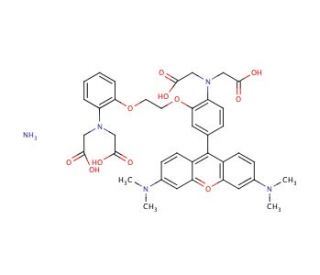

RHOD 2 triammonium salt (CAS 129787-65-1)
QUICK LINKS
RHOD 2 triammonium salt is a potent fluorescent dye used extensively in cell biology research to monitor and measure intracellular calcium (Ca²⁺) levels, crucial for understanding cellular signaling and function. Unlike some other calcium indicators, RHOD 2 is characterized by its red fluorescence, which allows researchers to use it in combination with other fluorophores like GFP (green fluorescent protein) without spectral overlap, facilitating multi-parameter imaging studies. The triammonium salt form of RHOD 2 enhances its water solubility, making it easier to load into cells. Once inside the cell, RHOD 2 is typically esterified to enable cell membrane permeability. Cellular esterases then cleave these ester groups, trapping the active dye within the cell where it can bind to calcium ions. This binding significantly enhances the dye′s fluorescence intensity, which is directly proportional to the concentration of calcium within the cell. This characteristic makes RHOD 2 invaluable for real-time studies of dynamic calcium signaling events such as muscle contraction, neuronal activity, and various cellular response mechanisms to physiological or pharmacological stimuli. The use of RHOD 2 in research has been pivotal for dissecting the intricacies of calcium-mediated intracellular processes, offering insights into the complex and vital roles of calcium as a key secondary messenger in cellular physiology.
RHOD 2 triammonium salt (CAS 129787-65-1) References
- Cyclic AMP-dependent phosphorylation of the inositol-1,4,5-trisphosphate receptor inhibits Ca2+ release from platelet membranes. | Quinton, TM. and Dean, WL. 1992. Biochem Biophys Res Commun. 184: 893-9. PMID: 1315537
- Mechanisms of cholecystokinin-induced protection of cultured cortical neurons against N-methyl-D-aspartate receptor-mediated glutamate cytotoxicity. | Tamura, Y., et al. 1992. Brain Res. 592: 317-25. PMID: 1360313
- The expression of presynaptic t-ACPD receptor in rat cerebellum. | Takagi, H., et al. 1992. Biochem Biophys Res Commun. 189: 1287-95. PMID: 1362347
- Effects of the N-methyl-D-aspartate antagonists on the rise in [Ca2+]i following depolarization in aged rat brain synaptosomes. | Okada, M., et al. 1992. Brain Res. 583: 227-36. PMID: 1387038
- Fluorescent indicators for cytosolic calcium based on rhodamine and fluorescein chromophores. | Minta, A., et al. 1989. J Biol Chem. 264: 8171-8. PMID: 2498308
- Confocal microscopy reveals coordinated calcium fluctuations and oscillations in synaptic boutons. | Melamed, N., et al. 1993. J Neurosci. 13: 632-49. PMID: 8426230
Ordering Information
| Product Name | Catalog # | UNIT | Price | Qty | FAVORITES | |
RHOD 2 triammonium salt, 1 mg | sc-202789 | 1 mg | $390.00 |
